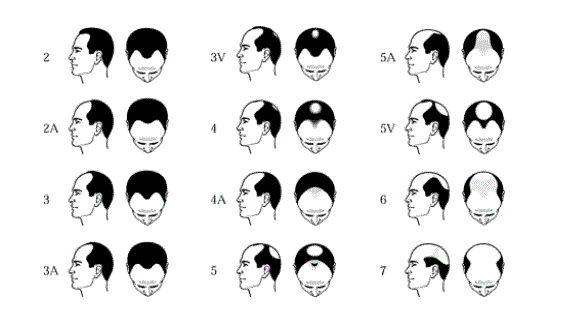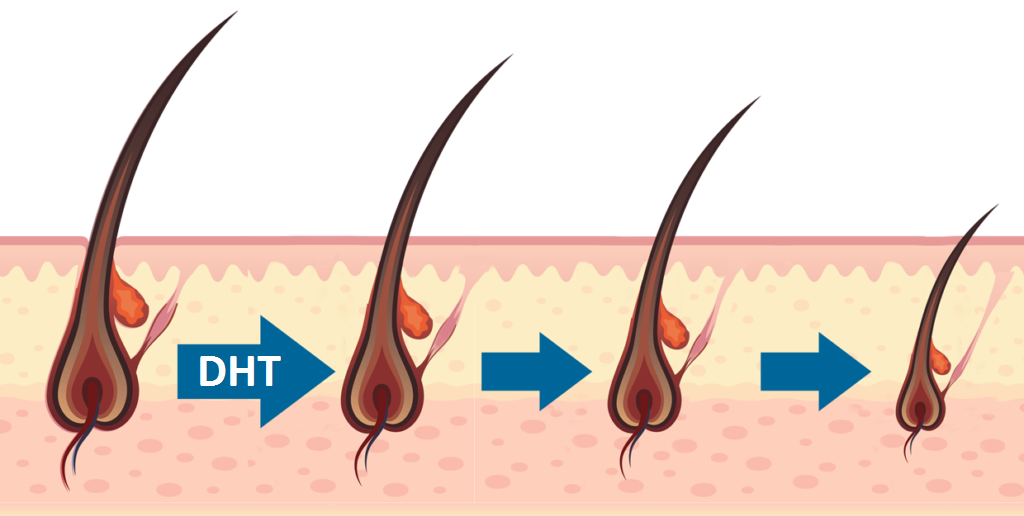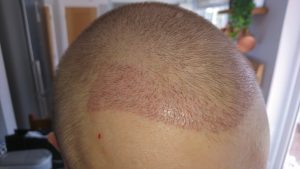What causes hair loss? There are different forms of hair loss but the most common is Androgenetic Alopecia, also known as Male Pattern Baldness in men (MPB), or Female Pattern Hair Loss (FPHL) in women.
For 95% of male hair loss sufferers the type of hair loss experienced is MPB. FPHL accounts for approximately 50% of female hair loss sufferers.
It’s varied more in women due to different hormonal factors or influences, such as contraception for example. For men, MPB is a fairly safe assumption.
For women, especially younger women experiencing hair loss I would advise speaking to your doctor. FPHL doesn’t usually present itself until your 50’s or 60’s.
Whether you are male or female it does no harm to consult a doctor and have your prognosis confirmed before starting to treat your hair loss. Knowing your type of hair loss is essential before beginning treatment.
What does Androgenetic Alopecia look like? The hair on the top of your head is genetically predisposed to being vulnerable to hair loss.
Men see the effects in the crown or at the hairline first. Your hair becomes thinner and your scalp may become more exposed, you may even notice hair falling out.
You may see your hairline recede, or a bald patch starting to form at the crown. For some men, a small amount of hair loss is completely natural as you age and it may stop. For others, it may continue eventually leading to full baldness on top.
25% of men may see issues start to form around age 21. 60% of men see issues by their mid 30’s. Women normally retain their hairline but notice tinning or short hairs that won’t grow past a certain length all over the top of the head.
For women, this doesn’t typically start until your 50’s or 60’s, but it can occur as early as your 30’s or 40’s.


What causes Androgenetic Alopecia and how do I treat it? The most widely acknowledged cause of Androgenetic Alopecia (MPB or FPHL) is Dihydrotestosterone (DHT).
You will only make progress when you accept this and start to address the root cause of the issue, DHT. I spent nearly 3 years wasting time and money on other theories, such as diet, supplements, lifestyle changes, when and how I would wash my hair etc.
This was a complete waste of my time and money. And I missed my window of opportunity to reverse my situation with products, leaving surgery as my only option to restore my hairline.
What is Dihydrotestosterone, or DHT? DHT is simply a by-product of your testosterone. Both men and women have testosterone and the body converts and use it for different things.
It plays an essential role in your development in your teen years for example. Testosterone is converted to DHT by an enzyme called 5-Alpha Reductase (5AR). Your skin produces an oily substance called Sebum, which protects and moisturises it. Sebum contains DHT.
DHT attacks and weakens your hair follicles. First, it weakens the follicles making them look thinner. Then the hairs start to fall out and not grow back.
And then eventually the follicles die and are unable to grow hairs anymore. This process is called Miniaturisation. The hair on the top of your head is genetically predisposed to being more susceptible to the negative effects of DHT.
How can you combat DHT? Testosterone is converted to DHT by an enzyme called 5-Alpha Reductase (5AR). You can suppress the action of 5AR with oral medications like Finasteride (Propecia tablets).
Finasteride is said to lower your DHT levels by 60-70%. Lowering your DHT stops it from attacking your hair follicles, giving them a better environment to grow in. This has been the most effective product I have used to date.
Another option is to stimulate blood flow to the hair follicles with topical products such as Minoxidil (Regaine or Rogaine foam). Stimulating the follicles is said to prolong and promote hair growth.
However, it is important to note that products like this do not address the root cause, which we know is DHT.
So whist Minoxidil is highly rated it is said to become less effective over time. Another option is to use supplements to either lower your DHT levels or increase your blood flow.
Saw Palmetto for example is said to lower your DHT levels. I’ve seen some success with supplements, but so far I’ve found this method to be the least effective.
What is Miniaturisation? Miniaturisation is when hair follicles reduce in diameter and therefore produce finer, thinner looking hairs.
The follicles will also have a shorter Anagen (growth) phase. So the hairs will also not grow as long as they used to. Miniaturisation continues making the hairs finer and finer until the follicles cannot grow hairs anymore.
If you catch your hair loss early enough you can reverse Miniaturisation. If the follicles have stopped producing hairs though you may have missed your window of opportunity.

What are the phases of hair growth, and what does this mean?
Phase 1 – Anagen (The Growing Phase). This phase lasts between 2 and seven years. As you age the Anagen phase can reduce.
Phase 2 – Catagen (The Transition Phase). This lasts about 10 days. The hair follicle shrinks and detaches from the dermal papilla.
Phase 3 – Telogen (The Resting Phase). The resting phase lasts around 3 months. At any given point between 10 – 15% of our hairs are in this phase.
Phase 4 – Exogen (The Shedding Phase). Exogen is a part of the resting phase where the old hair sheds. You can shed between 50 and 150 hairs daily. This is normal and you may not even notice it.
Phase 5 – Kenogen (The Empty Phase). Between Exogen and Anagen, the follicle can appear empty for a period.

What this means is that if you start to treat your hair loss with products you will not notice a difference overnight. You may start to see improvements around 3 months.
But it will most likely take a year for you to see the full effect of the product you are using.


















